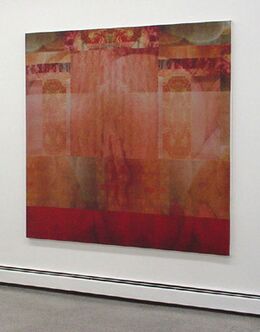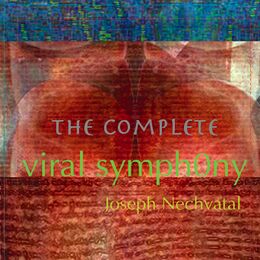Biography:Joseph Nechvatal
Joseph Nechvatal (born January 15, 1951)[1]:1176 is an American post-conceptual digital artist and art theoretician[2] who creates computer-assisted paintings and computer animations, often using custom-created computer viruses.
Life and work
Joseph Nechvatal was born in Chicago .[1]:1176 He studied fine art and philosophy at Southern Illinois University Carbondale, Cornell University and Columbia University.[1]:1176 He earned a Doctor of Philosophy in Philosophy of Art and Technology at the Planetary Collegium at University of Wales, Newport[3] and has taught art theory and art history at the School of Visual Arts.[3] He has had many solo exhibitions, including one in Berlin[4]
His work in the early 1980s chiefly consisted of postminimalist gray graphite drawings that were often photomechanically enlarged.[5] Beginning in 1979 he became associated with the artist group Colab, organized the Public Arts International/Free Speech series, and helped established the non-profit group ABC No Rio.[6] In 1983 he co-founded the avant-garde electronic art music audio project Tellus Audio Cassette Magazine.[7] In 1984, Nechvatal began work on an opera called XS: The Opera Opus (1984-6)[8] with the no wave musical composer Rhys Chatham.[9]
He began using computers and robotics to make post-conceptual paintings in 1986 [10] and later, in his signature work, began to employ self-created computer viruses.[11][12] From 1991 to 1993, he was artist-in-residence at the Louis Pasteur Atelier in Arbois, France and at the Saline Royale/Ledoux Foundation's computer lab. There he worked on The Computer Virus Project, his first artistic experiment with computer viruses and computer virus animation.[13] He exhibited computer-robotic paintings at Documenta 8 in 1987.[14][15]
In 2002 he extended his experimentation into viral artificial life through a collaboration with the programmer Stephane Sikora of music2eye in a work called the Computer Virus Project II.[16]
Nechvatal has also created a noise music work called viral symphOny, a collaborative sound symphony created by using his computer virus software at the Institute for Electronic Arts at Alfred University.[17][18][19] In 2021 Pentiments released Nechvatal's retrospective audio cassette called Selected Sound Works (1981-2021) and in 2022 his The Viral Tempest, a double vinyl LP of new audio work.[20]
From 1999 to 2013, Nechvatal taught art theories of immersive virtual reality and the viractual at the School of Visual Arts in New York City (SVA). A book of his collected essays entitled Towards an Immersive Intelligence: Essays on the Work of Art in the Age of Computer Technology and Virtual Reality (1993–2006) was published by Edgewise Press in 2009. Also in 2009, his book Immersive Ideals / Critical Distances was published.[21] In 2011, his book Immersion Into Noise was published by Open Humanities Press in conjunction with the University of Michigan Library's Scholarly Publishing Office.[22]
Viractualism
Viractualism is an art theory concept developed by Nechvatal in 1999[23][24] from Ph.D. research [25] Nechvatal conducted at the University of Wales College. There he developed his concept of the viractual, which strives to create an interface between the actual and the virtual.[26]
Footnotes
- ↑ 1.0 1.1 1.2 Sara Pendergast; Tom Pendergast (2002). Contemporary artists (5th ed.). Detroit, MI: St. James Press. ISBN 1-55862-488-0. OCLC 47869983.
- ↑ Brier, Søren (2017). "Systems, Power, and the Phenomenological Basis of Triadic Semiotics". Cybernetics and Human Knowing 24 (2): 5–8. https://chkjournal.com/node/251. Retrieved 3 April 2021.
- ↑ 3.0 3.1 [1]ZKM Center for Art and Media Karlsruhe lecture page Joseph Nechvatal: Immersion Into Noise
- ↑ "bOdy pandemOnium. Immersion into Noise" (in De-de). https://www.art-in-berlin.de/ausstellungs-text.php?id=11027.
- ↑ Collins, Tricia; Milazzo, Richard (1990). "Deprivileging Critique". Collected essays 1983-1990. Paris: Editions Antoine Candau. pp. 3–7. ISBN 2-908139-02-2. OCLC 25610584. https://www.worldcat.org/oclc/25610584.
- ↑ Goodeve, Thyrza Nichols (2015-12-09). "THE MIGRANT AS CONSCIENTIOUS OBJECTOR JOSEPH NECHVATAL with Thyrza Nichols Goodeve" (in en-US). https://brooklynrail.org/2015/12/art/joseph-nechvatal-with-thyrza-nichols-goodeve.
- ↑ The downtown book : the New York art scene, 1974-1984. Marvin J. Taylor, Grey Art Gallery & Study Center, Fales Library, Andy Warhol Museum, Austin Museum of Art. Princeton, N.J.: Princeton University Press. 2006. ISBN 0-691-12286-5. OCLC 58832292. https://www.worldcat.org/oclc/58832292.
- ↑ Rhys Chatham, Die Donnergötter (LP, CD), Table of the Elements/Radium 2006, CD Book, p. 14
- ↑ Sharp, Willoughby (1984) (in English). Joseph Nechvatal. New York, N.Y.: Machine Language Books. OCLC 761232484. https://www.worldcat.org/oclc/761232484.
- ↑ Joseph Nechvatal, Selected Writings. Paris: Editions Antoine Candau, 1990
- ↑ Popper, Frank (2007). From technological to virtual art. Cambridge, Mass.: MIT Press. pp. 120–123. ISBN 978-0-262-16230-2. OCLC 57142521. https://www.worldcat.org/oclc/57142521.
- ↑ Lieser, Wolf (2009). Digital art. Köln: H.f. ullmann. pp. 87. ISBN 978-3-8331-5338-9. OCLC 319500677. https://www.worldcat.org/oclc/319500677.
- ↑ Robert C. Morgan Digital Hybrids, Art Press volume #255, pp. 75-76.
- ↑ Documenta 8 : Kassel 1987, 12. Juni-20. Sept.. Manfred Schneckenburger, Bazon Brock, Vittorio Fagone, Edward F. Fry, Documenta GmbH, Museum Fridericianum Veranstaltungs GmbH. Kassel: Weber & Weidemeyer. 1987. ISBN 3-925272-11-9. OCLC 16875226. https://www.worldcat.org/oclc/16875226.
- ↑ Nechvatal, J. 1987. Theoretical Statement Concerning Computer Robotic Paintings, Documenta 8 Catalogue, Vol. 3
- ↑ Liu, Alan (2004). The laws of cool : knowledge work and the culture of information. Chicago: University of Chicago Press. pp. 331–336 & 485–486. ISBN 978-0-226-48700-7. OCLC 688291784. https://www.worldcat.org/oclc/688291784.
- ↑ "Artist in Residence Archive". http://blogs.alfred.edu/iea/?page_id=159.
- ↑ "Joseph Nechvatal :: Viral symphony :: IEA :: 2007". http://sonhors.free.fr/kronik/Joseph_Nechvatal_viral_symphony.htm.
- ↑ Morgan, Robert (June 2012). "Joseph Nechvatal: nOise anusmOs". The Brooklyn Rail. http://brooklynrail.org/2012/06/artseen/joseph-nechvatal-noise-anusmos.
- ↑ Joseph Nechvatal / The Viral Tempest Interview at It’s Psychedelic Baby music magazine
- ↑ Nechvatal. J. Immersive Ideals / Critical Distances, LAP Lambert Academic Publishing (July 7, 2009) ISBN:3-8383-0445-4 / ISBN:978-3-8383-0445-8
- ↑ Immersion Into Noise published by Open Humanities Press in conjunction with the University of Michigan Library's Scholarly Publishing Office. Ann Arbor. 2011.
- ↑ Christiane Paul, in her book Digital Art, discusses Nechvatal's concept of viractualism on page 58. One of the images she chooses to illustrate that section of the book is Nechvatal's painting entitled the birth Of the viractual (2001). Joe Lewis, in the March 2003 issue of Art in America (pp.123-124), discusses the viractual in his review Joseph Nechvatal at Universal Concepts Unlimited. John Reed in Artforum Web 3-2004 Critic's Picks discusses the concept in his piece #1 Joseph Nechvatal. Frank Popper also writes about the viractual concept in his book From Technological to Virtual Art on page 122.
- ↑ "CTheory.net". http://www.ctheory.net/articles.aspx?id=330.
- ↑ The title of the Ph.D. dissertation is "Immersive Ideals / Critical Distances : A Study of the Affinity Between Artistic Ideologies Based in Virtual Reality and Previous Immersive Idioms". A url introduction to the thesis, entitled "Frame and Excess", can be read on-line and the entire thesis downloaded in PDF at: [2]
- ↑ Paul, Christiane (2008). Digital art (2 ed.). London: Thames & Hudson. pp. 55–58. ISBN 978-0-500-20398-9. OCLC 191753179. https://www.worldcat.org/oclc/191753179.
Further reading
- John Johnston, The Allure of Machinic Life: Cybernetics, Artificial Life, and the New AI, MIT Press, 2008, cover
- Donald Kuspit, The Matrix of Sensations VI: Digital Artists and the New Creative Renaissance
- Joline Blais and Jon Ippolito, The Edge of Art, Thames & Hudson Ltd, p. 213
- Frank Popper, From Technological to Virtual Art, MIT Press, pp. 120–123
- Johanna Drucker, [3] Joseph Nechvatal : Critical Pleasure
- Robert C. Morgan, Voluptuary: An algorithic hermaphornology, Tema Celeste Magazine, volume #93, p. 94
- Bruce Wands, Art of the Digital Age, London: Thames & Hudson, p. 65
- Robert C. Morgan, Laminations of the Soul, Editions Antoine Candau, 1990, pp. 23–30
- Margot Lovejoy, Digital Currents: Art in the Electronic Age Routledge 2004
- Joseph Nechvatal, Immersive Excess in the Apse of Lascaux, Technonoetic Arts 3, no3. 2005
- Joseph Nechvatal. Immersion Into Noise. Open Humanities Press in conjunction with the University of Michigan Library's Scholarly Publishing Office. Ann Arbor. 2011
- Johanna Drucker, Joseph Nechvatal : Critical Pleasure, Redaktion Frank Berndt, 1996, pp. 10–13
- Mario Costa, Phenomenology of New Tech Arts, Artmedia, Salerno, 2005, p. 6 & pp. 36 – 38
- Dominique Moulon, L'art numerique: spectateur-acteuret vie artificielle, Les images numeriques #47-48, 2004, pp. 124–125
- Christine Buci-Glucksmann, L'art à l'époque virtuel, in Frontières esthétiques de l'art, Arts 8, Paris: L'Harmattan, 2004
- Brandon Taylor, Collage, Thames & Hudson Ltd, 2006, p. 221
- Dominique Moulon, [4] Conférence Report : Media Art in France, Un Point d'Actu, L'Art Numerique, pp. 124–125
- Edmond Couchot, Des Images, du temps et des machines, édité Actes Sud, 2007, pp. 263–264
- Fred Forest, Art et Internet, Editions Cercle D'Art / Imaginaire Mode d'Emploi, pp. 48 –51
- Wayne Enstice & Melody Peters, Drawing: Space, Form, & Expression, New Jersey: Prentice Hall, pp. 312–313
- Ellen K. Levy, Synthetic Lighting: Complex Simulations of Nature, Photography Quarterly (#88) 2004, pp. 7–9
- Marie-Paule Nègre, Des artistes en leur monde, volume 2, la Gazette de l'Hotel Drout, 2008, pp. 82–83
- Corrado Levi, È andata così: Cronaca e critica dell'arte 1970-2008, Joseph Nechvatal intervistato nel suo studio a New York (1985–86), pp. 130–135
- Donald Kuspit, Del Atre Analogico al Arte Digital in Arte Digital Y Videoarte, Kuspit, D. ed., Consorcio del Circulo de Bellas Artes, Madrid, pp. 33–34 & pp. 210 – 212
- Robert C. Morgan, Nechvatal's Visionary Computer Virus, in Gruson, L. ed. 1993. Joseph Nechvatal: Computer Virus Project, Royal Saltworks at Arc-et-Senans: Fondation Claude-Nicolas Ledoux, pp. 8–15
- Sarah J. Rogers (ed), Body Mécanique: Artistic Explorations of Digital Realms, Columbus, Ohio, Wexner Center for the Arts, The Ohio State University
- Edward A. Shanken, Art and Electronic Media. London: Phaidon, 2009. ISBN:978-0-7148-4782-5, pp. 42, 285, 160
External links
 |




